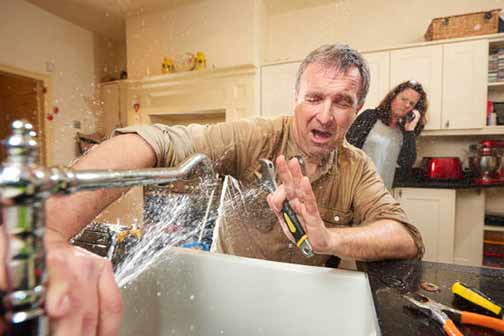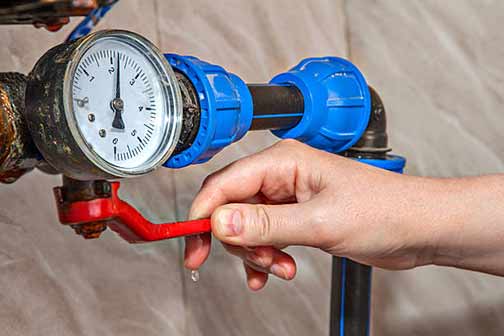
Water emergencies can occur at any time, often without warning. These emergencies can range from minor leaks to major flooding, and they can cause significant damage to your home and property. Understanding the different types of water emergencies and their potential impact is crucial for homeowners. Water emergencies may include burst pipes, leaking appliances, clogged drains, or even natural disasters like heavy rain or hurricanes. Each type of emergency requires prompt and appropriate action to mitigate damage and ensure the safety of your home.
Burst pipes are one of the most common and severe types of water emergencies. They can result from freezing temperatures, high water pressure, or deteriorating pipe materials. When a pipe bursts, it can release a large amount of water in a short period, causing extensive damage to walls, floors, and personal belongings. Leaking appliances, such as washing machines, dishwashers, and water heaters, can also lead to water emergencies.
These leaks may start small but can quickly escalate if not addressed promptly. Clogged drains can cause water to back up and overflow, leading to potential flooding and water damage. Natural disasters, such as heavy rain or hurricanes, can overwhelm drainage systems and cause widespread flooding, affecting not only your home but also the surrounding area.
The Importance of Shutting Off Your Water Supply: Preventing Further Damage
One of the most critical steps in managing a water emergency is knowing how to shut off your water supply. Shutting off the water supply can prevent further damage and give you time to address the issue. It is essential to act quickly to minimize the impact of the emergency on your home. By shutting off the water supply, you can stop the flow of water and prevent additional flooding or leaks. This can save you from costly repairs and potential health hazards associated with water damage, such as mold growth and structural weakening.
Water damage can lead to a host of problems, including weakened structural integrity, damaged electrical systems, and ruined personal belongings. Mold growth is another significant concern, as it can develop within 24 to 48 hours of water exposure. Mold can cause health issues, particularly for individuals with allergies or respiratory conditions.
By shutting off the water supply promptly, you can mitigate these risks and protect your home and family. Additionally, knowing how to shut off the water supply can help you respond more effectively to emergencies, reducing the time and effort required for cleanup and repairs.
Identifying Your Main Water Shut-Off Valve: Location and Accessibility
Every homeowner should know the location of their main water shut-off valve. This valve is typically located near the water meter or where the main water line enters the house. Familiarize yourself with its location and ensure that it is easily accessible in case of an emergency. In some homes, the shut-off valve may be found in the basement, crawl space, or utility room. Mark the location of the valve with a visible tag or label, so you and other household members can quickly find it during an emergency.
It is also important to ensure that the area around the shut-off valve is free of clutter and obstacles. In an emergency, you may need to access the valve quickly, and any obstructions could delay your response. Additionally, consider installing a secondary shut-off valve if your main valve is difficult to reach or operate. This secondary valve can provide an additional layer of protection and make it easier to shut off the water supply in an emergency.
Regularly check the condition of your shut-off valve and make sure it is functioning properly. If you encounter any issues, such as a stuck or leaking valve, contact a professional plumber for assistance.
How to Shut Off Your Water Supply: Step-by-Step Guide
Shutting off your water supply is a straightforward process, but it is important to know the correct steps. First, locate the main water shut-off valve. Turn the valve clockwise to close it. If the valve is difficult to turn, use a wrench or pliers for assistance. Once the valve is closed, check that the water flow has stopped by turning on a faucet. It is a good idea to practice this procedure periodically to ensure that you can perform it quickly and efficiently in an actual emergency.
In addition to the main shut-off valve, it is helpful to know the location of individual shut-off valves for specific appliances and fixtures. These valves are typically located near the appliance or fixture they control, such as under sinks, behind toilets, or near water heaters. Knowing how to shut off these valves can allow you to isolate the problem area and continue using water in other parts of your home.
For example, if your washing machine is leaking, you can shut off the valve supplying water to the machine while still having access to water for other purposes. Practice turning off these individual valves to ensure you are familiar with their operation.
Preventive Measures to Avoid Water Emergencies: Proactive Steps
Preventive measures can help you avoid water emergencies and protect your home. Regularly inspect your plumbing system for signs of wear and tear, such as leaks, corrosion, or rust. Install water leak detectors and automatic shut-off valves to detect and stop leaks before they cause significant damage. Additionally, consider insulating your pipes to prevent them from freezing during cold weather. Ensure that appliances like washing machines, dishwashers, and water heaters are in good working condition and are serviced regularly. Proper landscaping and drainage around your home can also help prevent water from entering your home during heavy rains.
Water leak detectors are valuable tools that can alert you to potential leaks before they become major problems. These devices can be placed near appliances, under sinks, and in other areas prone to leaks. When water is detected, the alarm sounds, allowing you to take immediate action. Automatic shut-off valves can be installed on your main water line or individual appliances. These valves automatically close when a leak is detected, stopping the flow of water and preventing further damage.
Insulating your pipes is another effective preventive measure, particularly in colder climates. Frozen pipes can burst and cause significant water damage, so proper insulation can help maintain a consistent temperature and prevent freezing.

What to Do During a Water Emergency: Immediate Actions
During a water emergency, it is important to stay calm and take immediate action. First, shut off the main water supply to prevent further damage. Next, assess the situation and determine the source of the problem. If the issue is a minor leak, you may be able to fix it yourself. However, for major issues such as burst pipes or flooding, it is best to contact a professional plumber for assistance. Document the damage with photographs and contact your insurance company to report the incident. Follow their instructions for filing a claim and arranging for repairs.
In addition to shutting off the water supply, take steps to minimize water damage. Move valuable items and furniture to a dry area, and use towels or mops to soak up excess water. If the water emergency is caused by a natural disaster, such as a flood, prioritize your safety and evacuate if necessary. Follow the guidance of local authorities and emergency services.
Once the immediate danger has passed, begin the cleanup process and assess the extent of the damage. Keep detailed records of the damage and any repairs you make, as this information will be important when filing an insurance claim.
Maintaining Your Plumbing System: Routine Care and Inspections
Regular maintenance of your plumbing system can help prevent water emergencies and extend the lifespan of your pipes and fixtures. Schedule annual inspections with a professional plumber to identify and address potential issues. Additionally, perform routine maintenance tasks such as cleaning drains, checking for leaks, and replacing worn-out fixtures. Be mindful of what you put down your drains, as grease, hair, and other debris can cause clogs and lead to water backups. Educate your family members on proper plumbing practices to ensure that everyone contributes to the upkeep of the system.
During a professional inspection, the plumber will check for signs of wear and tear, corrosion, and potential leaks. They may also use specialized equipment, such as cameras, to inspect the interior of your pipes and identify hidden issues. Addressing these issues early can prevent more serious problems and costly repairs. In addition to professional inspections, perform regular maintenance tasks yourself.
Clean drains regularly to prevent clogs, and use drain covers to catch hair and debris. Check for leaks around faucets, toilets, and appliances, and repair any issues promptly. Replace worn-out fixtures, such as washers and seals, to prevent leaks and ensure proper functioning.
When to Call a Professional Plumber: Recognizing the Signs
While some water emergencies can be handled by homeowners, others require the expertise of a professional plumber. If you encounter a major issue such as a burst pipe, extensive flooding, or a persistent leak that you cannot fix, it is important to call a plumber immediately. Professional plumbers have the tools and experience to address complex problems and prevent further damage to your home. They can also provide valuable advice on maintaining your plumbing system and preventing future emergencies. Keep the contact information of a reliable plumber handy, so you can reach them quickly in case of an emergency.
Recognizing the signs that you need an emergency plumber can save you time, money, and stress. If you notice a sudden drop in water pressure, discolored water, or unusual noises coming from your pipes, these could be indications of a more serious problem. Persistent clogs, slow drains, and foul odors are also signs that you may need professional assistance.
Additionally, if you experience multiple plumbing issues simultaneously, it is likely that there is an underlying problem that requires a plumber’s expertise. Do not hesitate to call a professional if you are unsure about the severity of a plumbing issue. It is better to address the problem early than to risk further damage and costly repairs.
Conclusion: Staying Prepared and Proactive
Staying ahead of water emergencies is essential for protecting your home and property. By understanding the importance of shutting off your water supply, identifying your main water shut-off valve, and taking preventive measures, you can minimize the risk of water-related damage. Regular maintenance and knowing when to call a professional plumber are also key components of effective water emergency management. By following this guide, homeowners can be better prepared to handle water emergencies and safeguard their homes. Remember that preparation and prompt action are your best defenses against water-related disasters.
In addition to the steps outlined in this guide, consider creating an emergency plan for your household. This plan should include the location of the main water shut-off valve, contact information for a reliable plumber, and instructions for addressing common water emergencies.
Share this plan with all household members and practice the procedures regularly. Being prepared and proactive can make a significant difference in how effectively you respond to water emergencies and protect your home from damage.

